Birdfinding.info ⇒ The South American form of the Short-eared Owl is uncommon and local. Areas where it has been found with some regularity include: Humedal de Jaboque, near the Bogotá airport; Avenida Giaconda Cibim in Santa Bárbara d’Oeste, São Paulo; the enivrons of Necochea in Buenos Aires Province; Puerto Montt, Chile; and Ruta Lago Sarmiento in Torres del Paine National Park.
“Southern Short-eared Owl”
Asio flammeus suinda
Grasslands of South America.
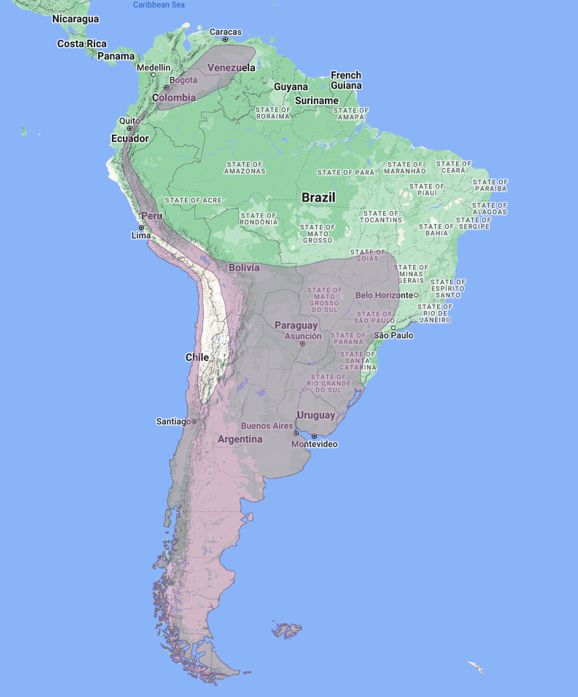
Approximate distribution of the “Southern Short-eared Owl”. © Xeno-Canto 2023
Occurs locally in several regions of South America, but inexplicably absent or scarce in many areas of extensive, apparently suitable habitat.
In the north, it is resident in the Andes of central Colombia and disjunctively in the Andes of Ecuador and southwestern Colombia, mainly at elevations of ~2,500-4,000 m.
It is occasionally detected in the Llanos of Colombia and western Venezuela, and in the grasslands of Roraima and western Guyana, but the paucity of records suggests that it is not permanently established in these areas.
In the center-west, it is rare and local in wetlands along the coast from Lambayeque to Tacna, and in the Andes of Cajamarca, Junín, Ayacucho, Cuzco, Puno, La Paz, and Cochabamba. Whether it is a resident or occasional visitor in many of these areas remains unclear.
In the east and south, it occurs more or less contiguously from central Chile, northern Argentina (Jujuy), and the Brazilian cerrado (north to southern Mato Grosso and southern Piauí) south to Tierra del Fuego. Within this area, its main centers of abundance are: south-central Chile; southern Patagonia; the pampas of central and eastern Argentina; and south-central Brazil (São Paulo and Paraná).
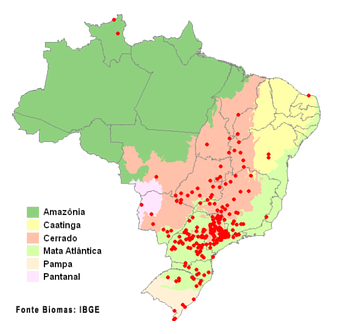
Brazilian records of the “Southern Short-eared Owl”, by municipality. © WikiAves 2023
Also occurs on the Falkland Islands and Juan Fernández Islands (at least on Isla Robinson Crusoe and Santa Clara). Its status on the latter islands is unclear in light of their remoteness and small land area—seemingly too small to support an owl population and too remote for regular inflow from mainland populations.
Southern populations appear to be partly sedentary and partly migratory or dispersive. Vagrants have been recorded from Trinidad, Barbados, and Rio Grande do Norte. Its apparently sporadic occurrence in several areas (e.g., the Llanos, Roraima, Guyana, the Peruvian coastal plain, and the Peruvian and Bolivian Andes) may be the result of dispersal or migration from well-established population centers farther south.
Identification
Very similar to the widespread “Northern Short-eared Owl”, but darker overall, more solid brown above, and buffier below. “Southern” may be visually indistinguishable from the “Antillean Short-eared Owl”.
Like other forms of Short-eared Owl, the “Southern” form is largely diurnal, but also active at night and most active around dusk. Short-eared Owls often hunt on the wing, flying low over open terrain, with a meandering, harrier-like flight pattern that alternates between deep, floppy wingbeats and long glides.

“Southern Short-eared Owl”, A. f. suinda (or possibly pallidicaudus—if this is a valid taxon, which seems unlikely). (Caroni ricefields, Trinidad; May 30, 2012.) © Nigel Lallsingh
The plumage is mainly dark-brown and buffy overall. The upperparts are mostly dark-brown with buffy spots; and the underparts are mostly buffy with dark-brown streaks.
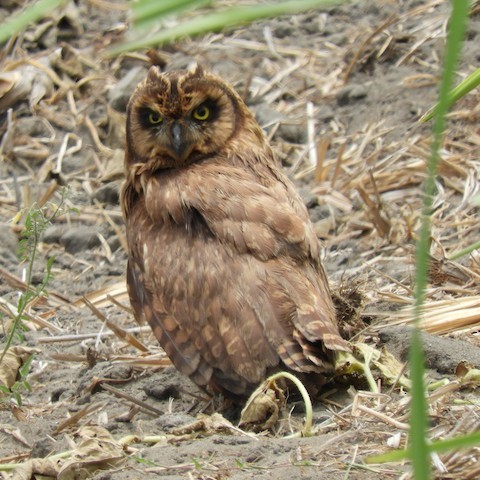
“Southern Short-eared Owl”, A. f. suinda, with atypically uniform brown upperparts. (El Milagro, La Libertad, Peru; October 16, 2018.) © Cliff Cordy
Like the “Antillean” form, “Southern” typically shows a distinct facial disk—mostly buffy, rusty, or brownish, with a dark-brown frame and a black shadow around each eye. The eyes are yellow and the bill is black.
Like the “Northern” form, many “Southerns” also have contrasting white crescents at the outer edge of the facial disk. On some individuals the frame is predominantly white.
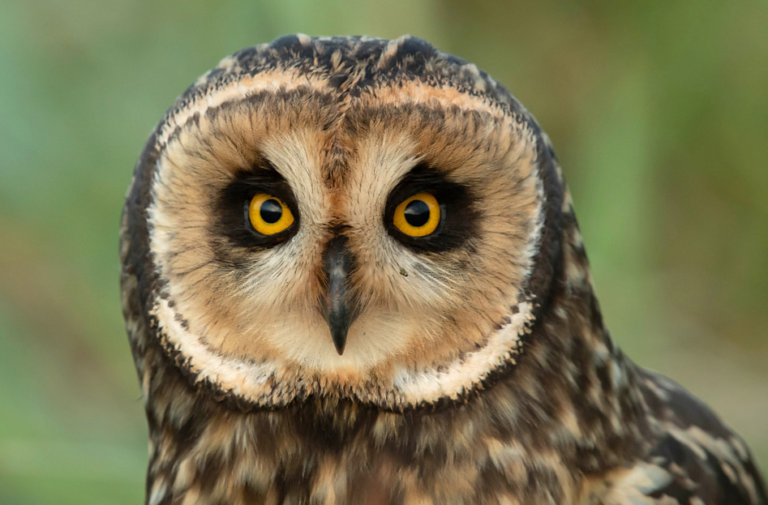
“Southern Short-eared Owl”, A. f. suinda, facial close-up showing whitish coloration in the border of the facial disk. (Americana, São Paulo, Brazil; April 3, 2019.) © Marcelo Figueiroa
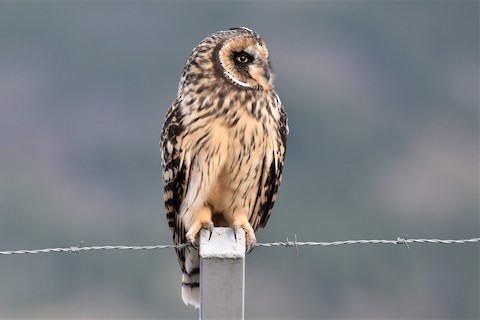
“Southern Short-eared Owl”, A. f. suinda. (Americana, São Paulo, Brazil; April 14, 2018.) © Cristiane Stubing
The streaking on the underparts is dense and thick on the chest, becoming progressively sparser on the lower breast and belly.
In flight, as on all Short-eared Owls, the upperside of the wing is mostly brow with large buffy patch in the primaries, and the underside of the wing is mostly pale with a prominent black crescent at the base of the primaries.
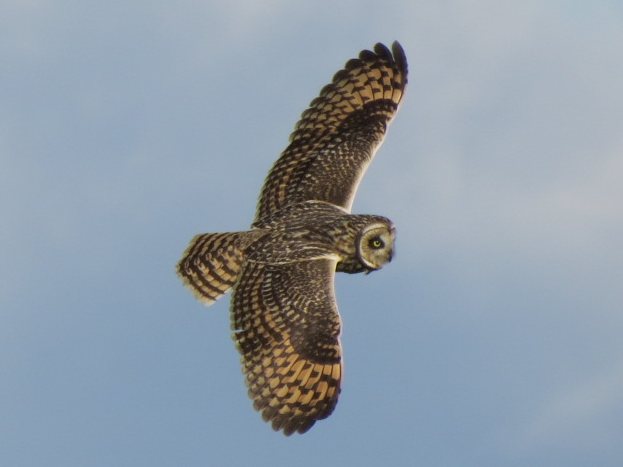
“Southern Short-eared Owl”, A. f. suinda, dorsal view in flight showing the large buffy patches in the primaries. (São Sebastião do Paraíso, Minas Gerais, Brazil; December 14, 2014.) © Jose Quintino
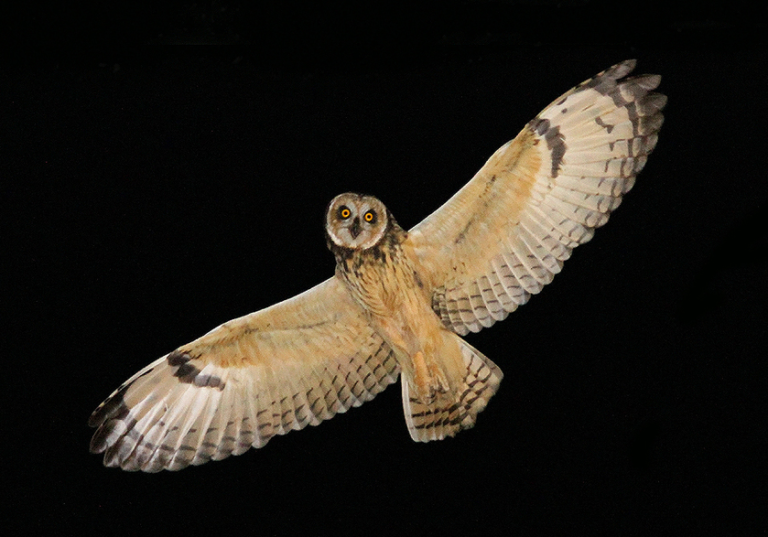
“Southern Short-eared Owl”, A. f. suinda, ventral view in flight showing the prominent black crescents at the bases of the primaries. (Americana, São Paulo, Brazil; June 3, 2015.) © Antonio Bordignon
Notes
Polytypic form consisting of three or four recognized subspecies, collectively one of five potentially distinct forms of Short-eared Owl.
The traditionally recognized subspecies pallidicaudus of Venezuela, Roraima, and Guyana seems unlikely to be a valid taxon as there appear to be no continuously established population in its range.
More Images of the “Southern Short-eared Owl”
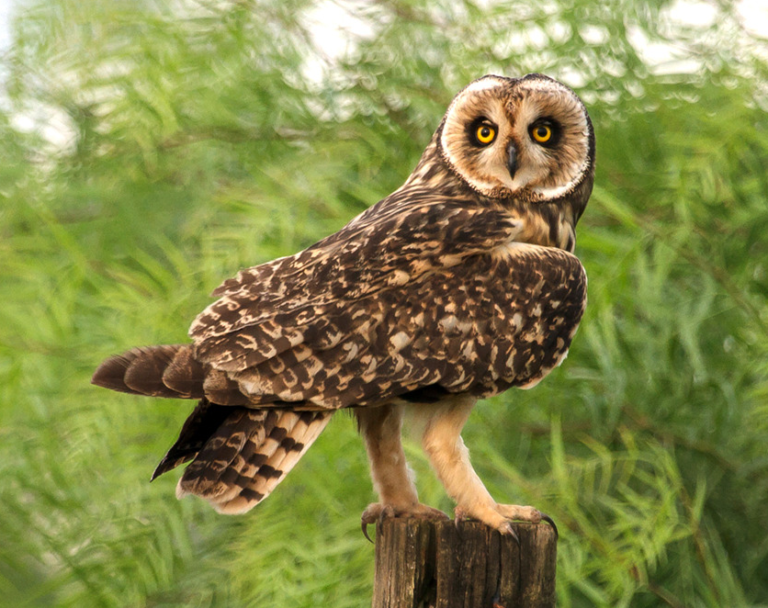
“Southern Short-eared Owl”, A. f. suinda. (Americana, São Paulo, Brazil; April 14, 2018.) © Cristiane Stubing

“Southern Short-eared Owl”, A. f. suinda. (Uquisilla, Puno, Peru; June 13, 2015.) © Ronald Hinojosa Cardenas
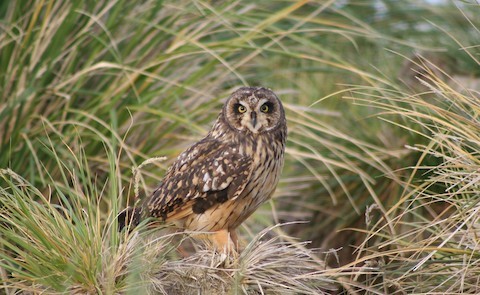
“Southern Short-eared Owl”, A. f. sanfordi. (Kidney Island, Falkland Islands; February 19, 2006.) © Alan Henry
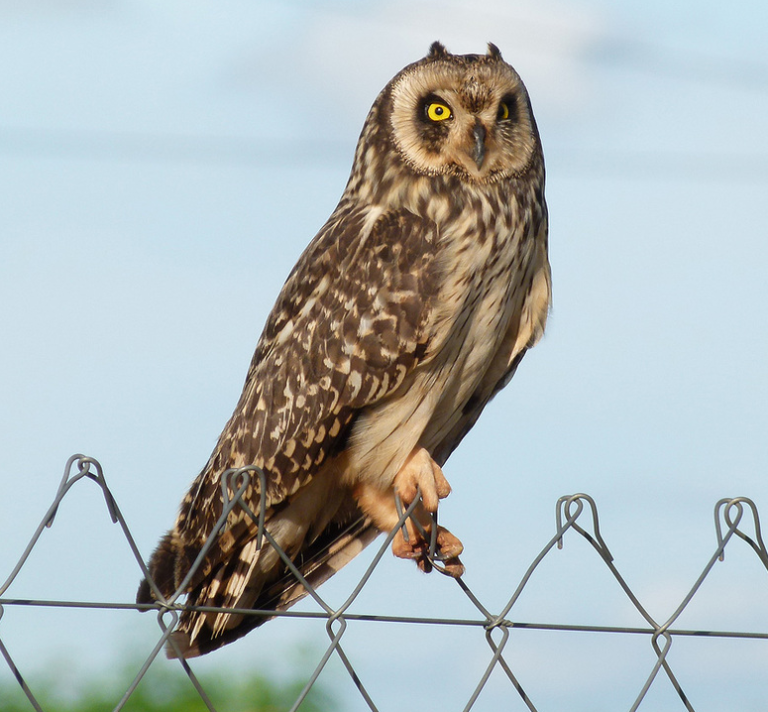
“Southern Short-eared Owl”, A. f. suinda. (Americana, São Paulo, Brazil; April 6, 2013.) © Ubaldo Neto
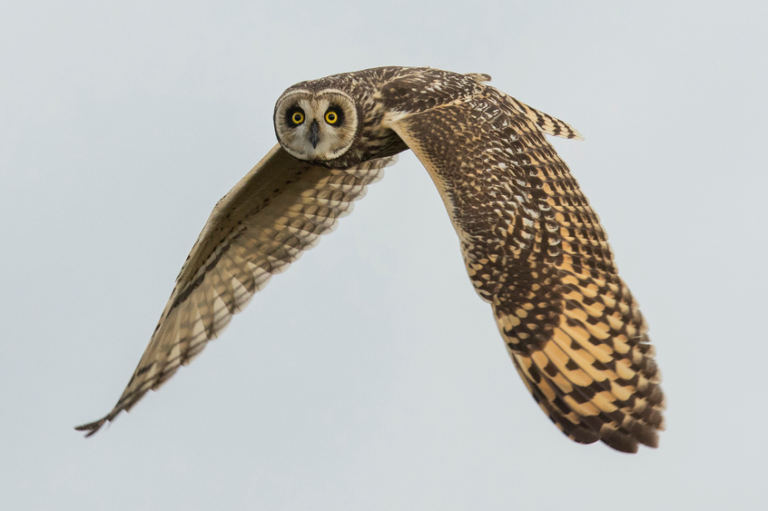
“Southern Short-eared Owl”, A. f. suinda, dorsal view in flight showing the large buffy patch in the primaries. (São Roque de Minas, Minas Gerais, Brazil; March 19, 2013.) © Fabio Rage
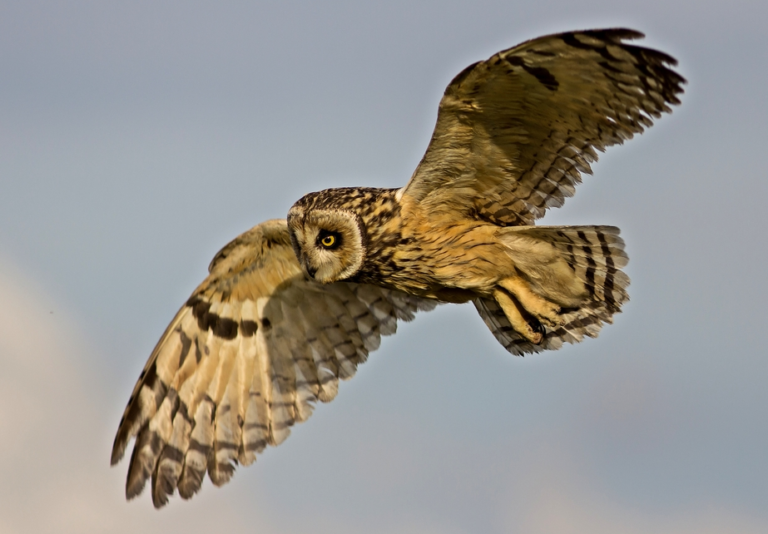
“Southern Short-eared Owl”, A. f. suinda, ventral view in flight showing the prominent black crescents at the bases of the primaries. (Americana, São Paulo, Brazil; June 14, 2014.) © Rogério Machado
References
Ascanio, D., G.A. Rodriguez, and R. Restall. 2017. Birds of Venezuela. Christopher Helm, London.
BirdLife International. 2021. Asio flammeus. The IUCN Red List of Threatened Species 2021: e.T22689531A202226582. https://dx.doi.org/10.2305/IUCN.UK.2021-3.RLTS.T22689531A202226582.en. (Accessed January 27, 2023.)
de la Peña, M.R., and M. Rumboll. 1998. Birds of Southern South America and Antarctica. Princeton University Press.
eBird. 2023. eBird: An online database of bird distribution and abundance. Cornell Lab of Ornithology, Ithaca, N.Y. http://www.ebird.org. (Accessed January 27, 2023.)
Erize, F., J.R. Rodriguez Mata, and M. Rumboll. 2006. Birds of South America: Non-Passerines: Rheas to Woodpeckers. Princeton University Press.
ffrench, R. 2012. A Guide to the Birds of Trinidad & Tobago (Third Edition). Cornell University Press.
iNaturalist. 2023. https://www.inaturalist.org/. (Accessed January 27, 2023.)
Kenefick, M., R. Restall, and F. Hayes. 2008. Field Guide to the Birds of Trinidad & Tobago. Yale University Press.
König, C., and F. Weick. 2008. Owls of the World (Second Edition). Yale University Press.
Martínez Piña, D.E., and G.E. González Cifuentes. 2021. Field Guide to the Birds of Chile. Princeton University Press.
McMullan, M., and T. Donegan. 2014, Field Guide to the Birds of Colombia (Second Edition). Fundación Proaves de Colombia, Bogotá.
Mikkola, H. 2017. Owls of the World: A Photographic Guide: Second Edition. Firefly Books, London.
Ridgely, R.S., and P.J. Greenfield. 2001. The Birds of Ecuador, Volume II: Field Guide. Cornell University Press.
Schulenberg, T.S., D.F. Stotz, D.F. Lane, J.P. O’Neill, and T.A. Parker. 2007. Birds of Peru. Princeton University Press.
van Perlo, B. 2009. A Field Guide to the Birds of Brazil. Oxford University Press.
Wikiaves. 2023. Mocho-dos-banhados, https://www.wikiaves.com.br/wiki/mocho-dos-banhados. (Accessed January 27, 2023.)
Xeno-Canto. 2023. Short-eared Owl – Asio flammeus. https://xeno-canto.org/species/Asio-flammeus. (Accessed January 27, 2023.)
